Nasutoceratops marked the first new release of 2023 from Haolonggood, a company which has been quickly climbing the popularity brands among collectors here on the Dinosaur Toy Blog. You’d be forgiven if you’re not quite familiar with the brand yet, though; Haolonggood has been around for a little while, but their company history hasn’t always been clear. Before we dive in to the toy ceratopsian itself, then, it might be worth taking a quick jaunt through what we currently know of Haolonggood’s development up until now, based on the information that’s been made available.
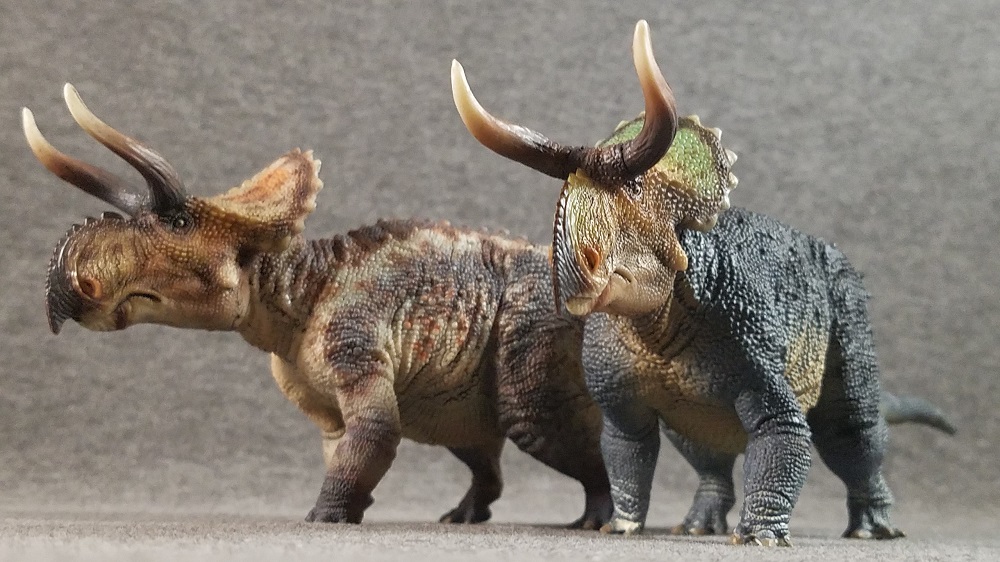
Haolonggood today is a company which has its own dedicated factory and production workshop; but back in 2019 the company’s eventual founder was working as a designer for the renowned PNSO brand. In 2020 Haolonggood began designing its own models; they collaborated with “sibling”* company MuSee for production, and the retail store/sales agent GR Toys for distribution. Their collaborations included an impressive Spinosaurus in 2020, followed by the even more celebrated Carcharodontosaurus and Dicraeosaurus pair in 2021. After a final collaboration on a model of Quetzalcoatlus in early 2022, the companies went separate ways, with Haolonggood releasing two more figures – Tyrannosaurus and Therizinosaurus – before the end of 2022. Enter the new year 2023, and Haolonggood has been continuing to develop and improve their designs to cater to the dinosaur enthusiast collectors’ market.
*not just a figurative term: the respective founders of Haolonggood and MuSee are genuine brothers, both of whom worked under departments of PNSO before going independent.
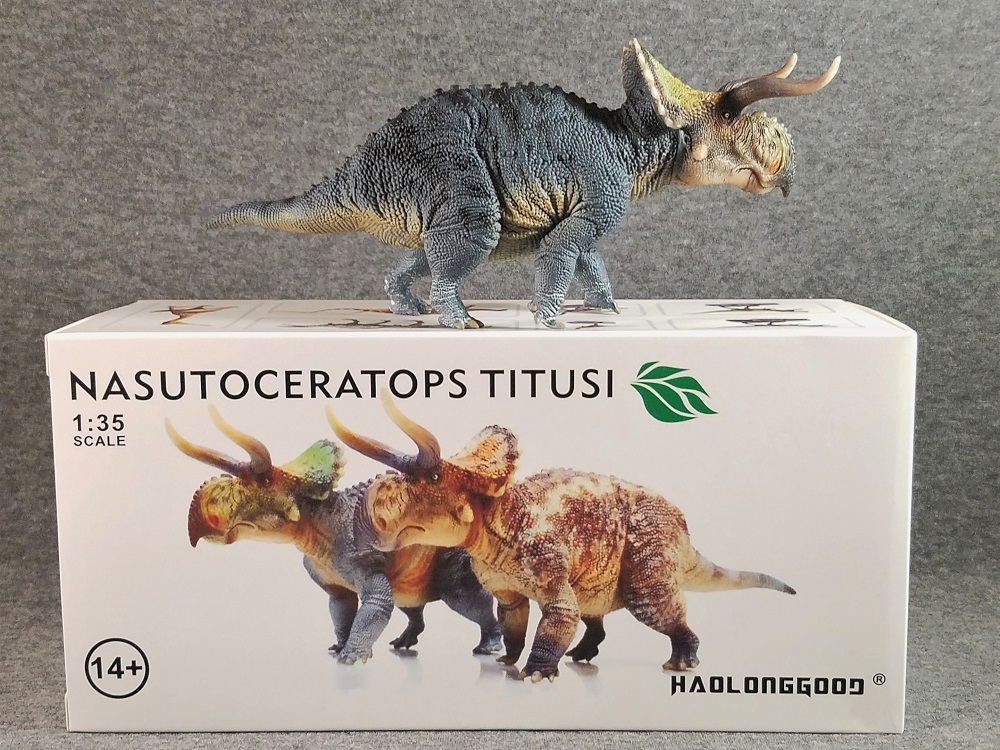
Released in March of 2023, Haolonggood’s Nasutoceratops is a fine example of the quality caliber the company continues to dedicate itself to. The figurine measures about 16.5 cm (6.5 in) straight from beak to tail; when measuring along the curve of the spine, the total length is closer to 18 cm. The animal’s life size is estimated at 4.5 meters (14.8 ft), which places the figurine around the 1:27-1:25 scale range. Comparisons between fossil and figure skulls yield a similar result of 1:26. This is a larger scale than advertised by Haolonggood, who marks the figures as 1:35 replicas; but precise dimensions and size discrepancies aside, Nasutoceratops displays quite splendidly alongside similar ceratopsians from PNSO and Safari Ltd.
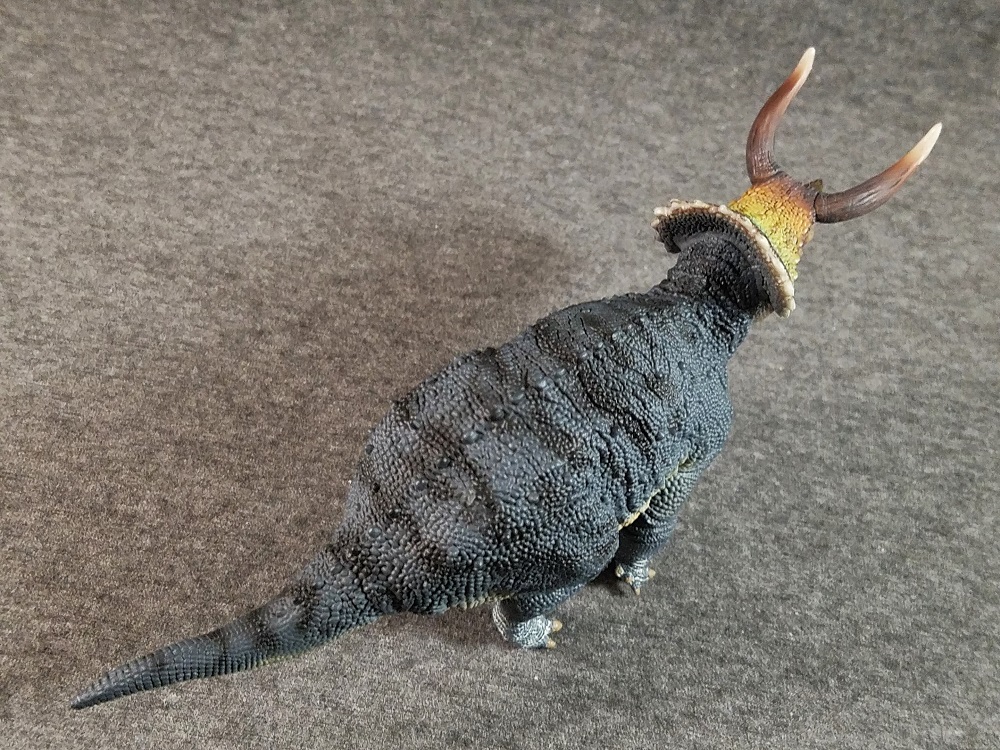
Nasutoceratops titusi, or “Titus’s Large-nosed horned-face”, was first described in 2013 from remains uncovered in Southern Utah, dating back to the Late Cretaceous. The fossils – consisting mostly of the skull and forelimbs – bear several interesting features for a centrosaurine ceratopsian, including pneumatic nasal bones and cattle-like brow horns as long as the animal’s snout. While Nasutoceratops might not be one of the most famous horned dinosaurs on record, it has achieved a surprising amount of representation in toy form already, with figurines released by Safari Ltd, Collecta, Mattel, and Creative Beast Studios, to name a few major examples. With this in mind, Haolonggood’s release may be a more shrewd choice than should be taken for granted, hitting a sweet spot between the cliched classic dino genera and the more obscure fan favorites.

Haolonggood’s dinosaurs typically come packaged in a secure foam brick, housed within an elegant white box displaying photographs of the figure, plus alternating English and Chinese text for the figure and the company. Like previous figures produced during the MuSee and GR Toys collaborations, Nasutoceratops comes in two color variants – nicknamed as YanQing (blue) and HuaRong (brown). Conveniently for this review, I was eager enough upon their release in the spring that I purchased both variants; so I’ll be comparing and contrasting the two here. While I was initially taken by the blue variant, the brown version has its own share of merits too. I think collectors will find either paint version highly satisfying.
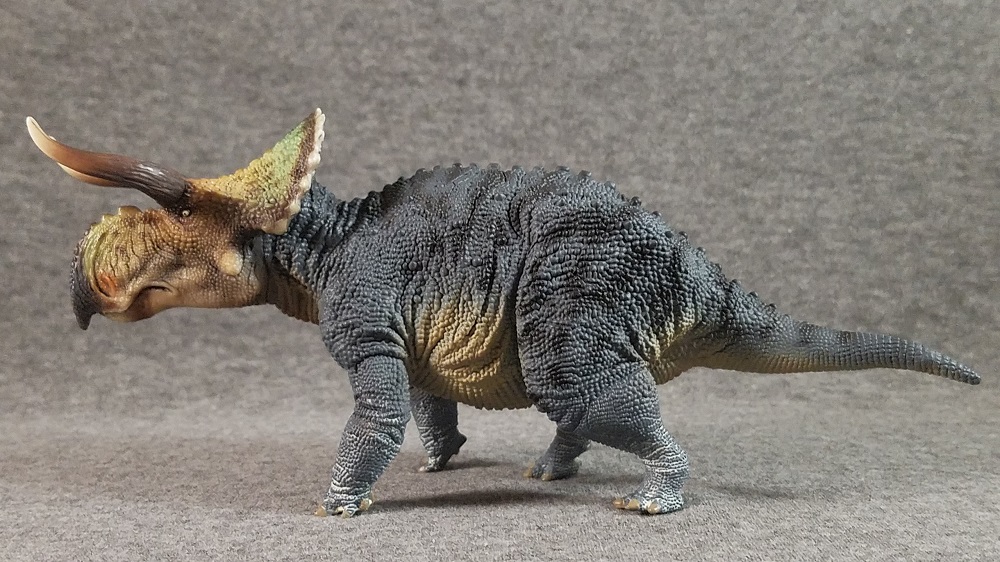
Some figurine companies, like Safari Ltd. and PNSO, have taken to relying on patterns of browns, yellows, and oranges so much that it’s become something of a tired joke with certain fans; thus, a deep navy-blue ceratopsian is a most welcome sight. Patterns are pretty simple on YanQing the blue Nasutoceratops, with irregular black striping across the back and haunches, and a light creamy-pinkish underbelly; however the effect is serviceable, and with the deep blue hue of the main body this figure is subdued yet striking. Punctuating the paint job further is the frill, decked out in a vibrant gradient of green, yellow, and a hint of orange. No rival or mate will have trouble identifying this horned face!
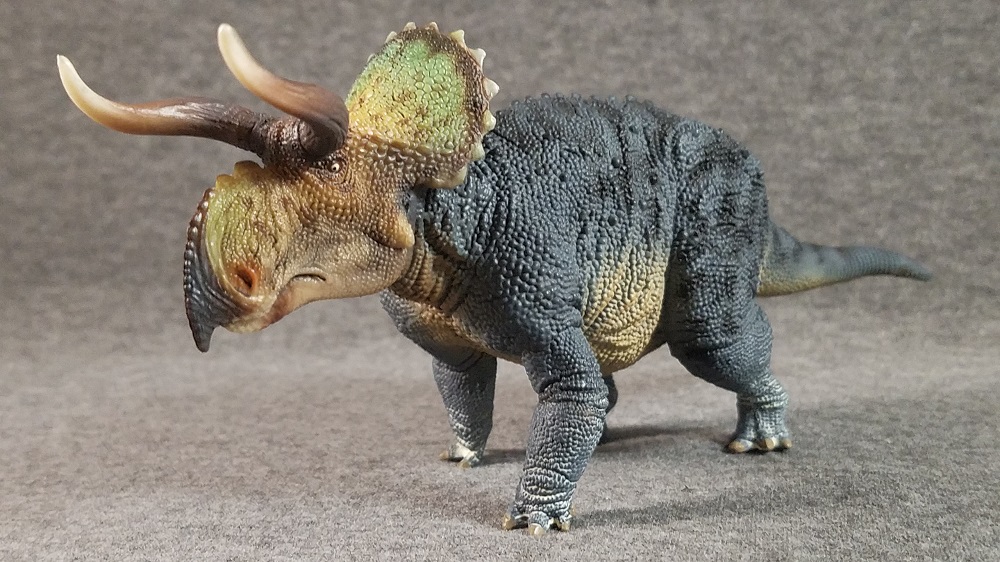
As nice as the blue Nasutoceratops is, though, HuaRong the brown variant arguably displays the caliber of Haolonggood’s paint applications much more strongly. What might look like a relatively simple pattern of brown and cream from a distance is vastly more intricate in close-up: spots and washes of gray-green and red-orange dapple the brown patches along the back and limbs, adding a complexity reminiscent of the intricacies one can find in the scale patterns of real modern-day reptiles. This mix of hues dissipates into the sides of the figure’s body, blending naturally into the creamy undersides and giving a lifelike unpredictability to the spots and stripes spread across the body and its extremities. If I were to mark one point of criticism, it’s that the frill – dirty cream with two large orange spots – sort of dissolves into the rest of the body’s coloration, unlike the more striking frill colors on the blue variant. That’s a relatively minor qualm given the overall excellence in this coloration, however.
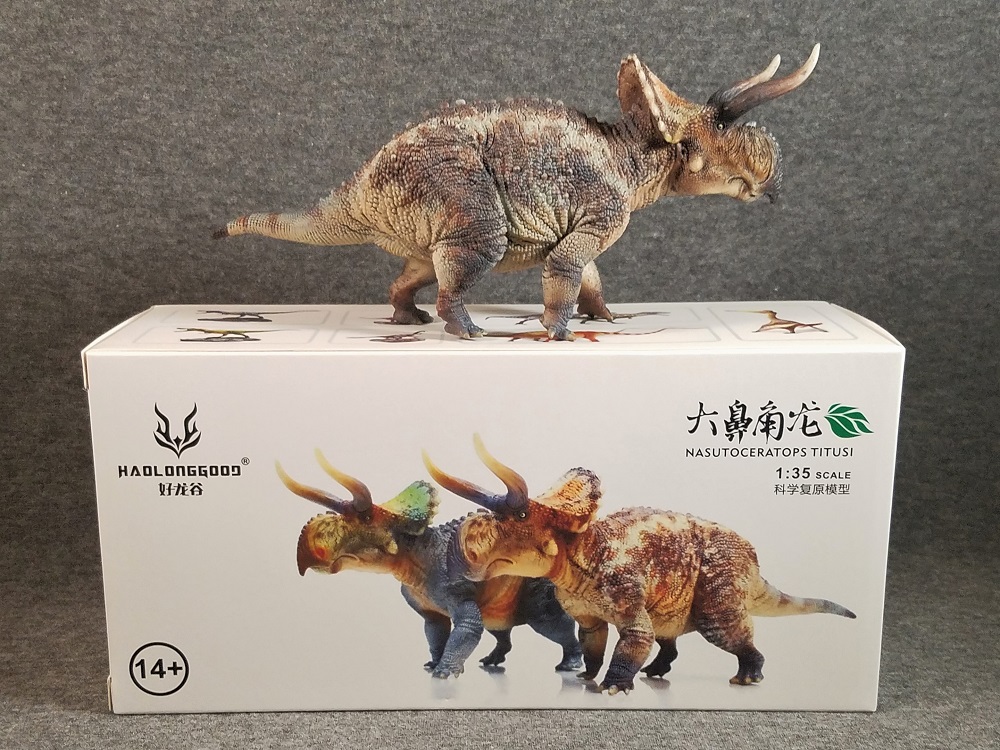
There are some shared details in the paint apps between the two figurines. Both versions have minor dark striping on their tails. The undersides are sprayed in lighter cream tints. The faces have gray shading and speckled patterns, bringing out greater detail in the shape of the skull; and the frills bear evenly dotted brown stripes running laterally front to end. The beaks are dark brownish-gray, and the horns are a dark brown until the tips, where they turn light cream again. These ceratopsians are not left wanting for presentation, that’s for sure. Once again, collectors will find themselves spoiled for choice between these two.

While both Nasutoceratops figurines are fine examples of Haolonggood’s strengths in the paint department, the base sculpt has plenty to commend as well – but the design isn’t infallible. Each model is richly textured with rounded scales of various sizes and arrangements; large osteoderms dot the animal’s back, finer scales adorn the skull, and even rows of more rectangular scales line the belly. With the possible exception of the osteoderms, the scalation on the models is highly exaggerated in size for the sake of appearance. Some collectors might find this off-putting when compared to the more nuanced detail work on figurines from similar brands (or even some of Haolonggood’s own models released since this one); personally I think it’s an acceptable look, given the challenges of reconstructing an extinct animal both realistically and aesthetically. The application of varying scale types, in addition to the stretches and folds of skin over the sculpt’s healthy musculature, looks convincing enough to compensate for any qualms with scale size for me – plus, quite honestly, those big scales are fun to feel when handling the model.

Of course, if we’re talking about serious reconstruction, it’s always important to reference whatever hard data is available in the fossil record. It’s here that, surprisingly, Haolonggood made some design choices collectors might have mixed feelings about. Nasutoceratops is only known from partial remains, including most of the skull and forelimbs, so a good reconstruction should certainly take those particular parts into close consideration, right? Well, the Haolonggood Nasutoceratops is unmistakable as the big-nosed herbivore in question, faithfully capturing the generously tall nasal ridge (no “horn”) seen in the holotype’s skull; however, some artistic license has been taken with the rest of the skull’s arrangement. The holotype skull of Nasutoceratops appears fairly level across its features, from frill to horns to snout. In Haolonggood’s interpretation, the frill and horns extend forward and back at steeper angles, giving the animal a silhouette that’s a little more striking, but not reflective of the few actual fossils we have representing this dinosaur to science. The swoops of the horns’ curvature have also been mildly embellished, enhancing the dinosaur’s superficial resemblance to a Texas longhorn cattle. Now, since the number of fossil specimens on record is so low, it’s not impossible that live Nasutoceratops might have displayed a lot of variety in horn and frill growth between individuals, so Haolonggood’s take could be reasonable. Those who prefer stricter adherence to the known fossil record might take umbrage with Haolonggood’s choices, however.
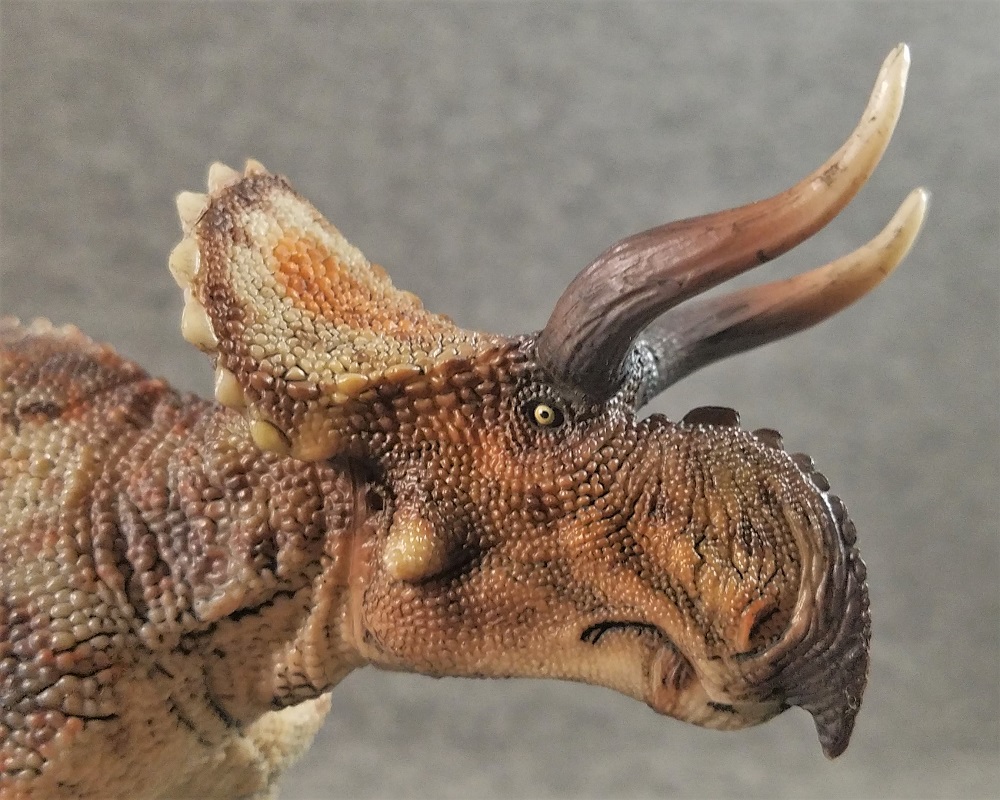
Elsewhere anatomical attentiveness appears good. The forelimbs match pretty closely to the fossil proportions, and the rest of the body looks consistent with typical ceratopsian features. Toes and foot pads are well-defined, and convey the sense of weight being carried with each step. The limbs and torso are amply fleshed-out; absolutely no shrinkwrapping is present here. If anything, the thigh regions are so enormous they might actually be TOO muscled. A row of large raised scales runs along the spine, with other osteoderms scattered over the skin as seen in skin samples from the distantly-related Triceratops. Every detail down to earholes and a cloaca have been accounted for; Haolonggood may have made curious choices about the skull, but they certainly aren’t negligent about the design.
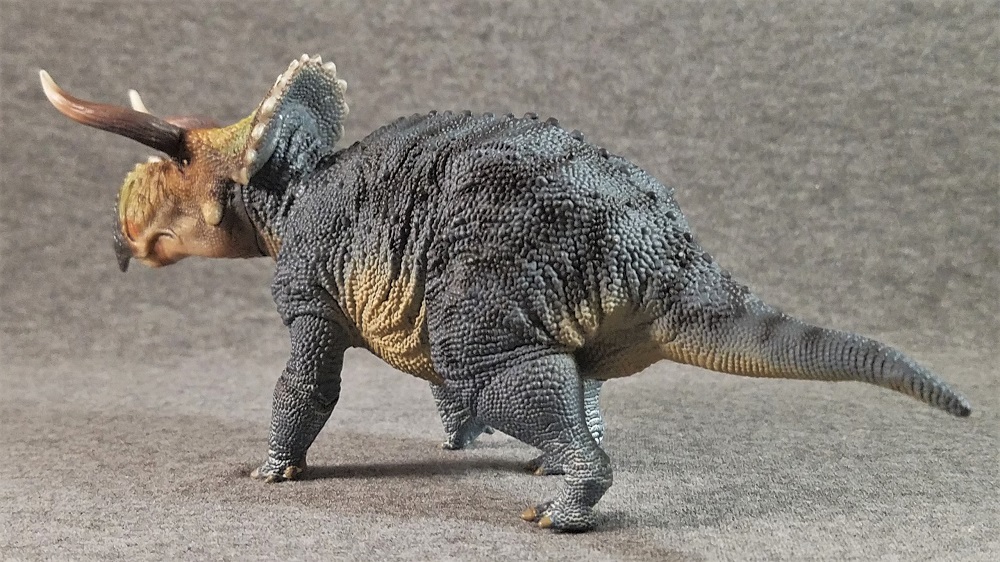
Nasutoceratops has unexpectedly achieved something akin to low-key star power, thanks to a short spotlight in in Jurassic World franchise and a variety of merchandising. Haolonggood’s take on this horned dinosaur isn’t without a few potential faults, but it’s a lovely figurine overall, and it displays beautifully as a single piece or a multicolored pair. Avid fans of horned dinosaurs will have little to complain about with adding these to the collection.
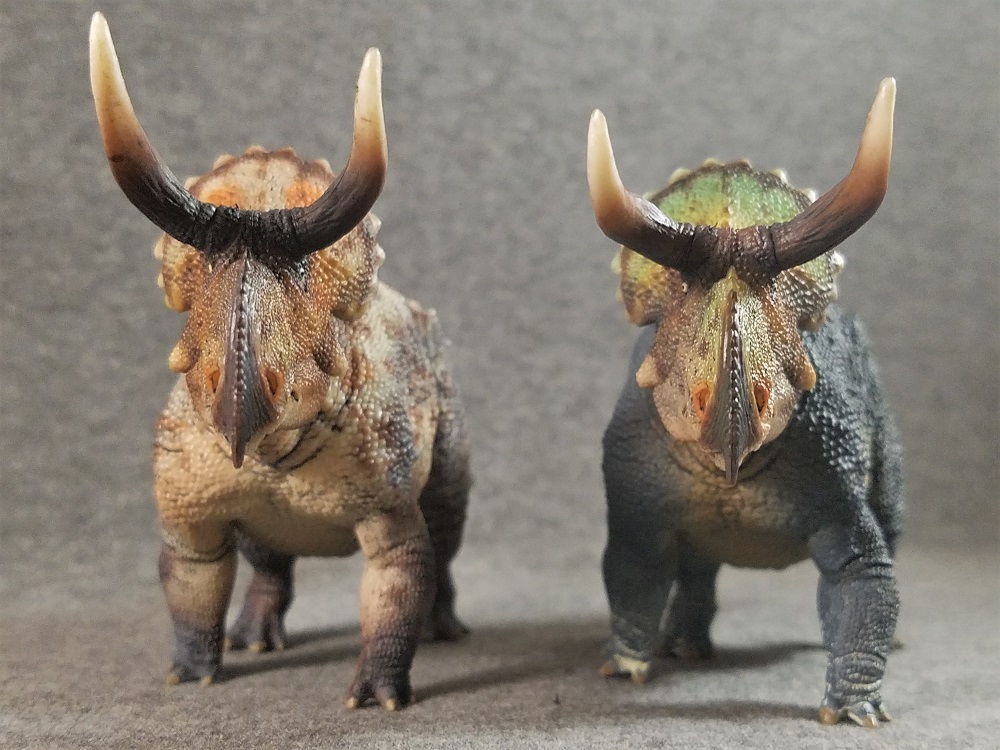
Nasutoceratops is also quite easy to acquire now, being available from Haolonggood’s official Amazon page, as well as several reputable websites including Everything Dinosaur, Happy Hen Toys, and Lana Time Shop.
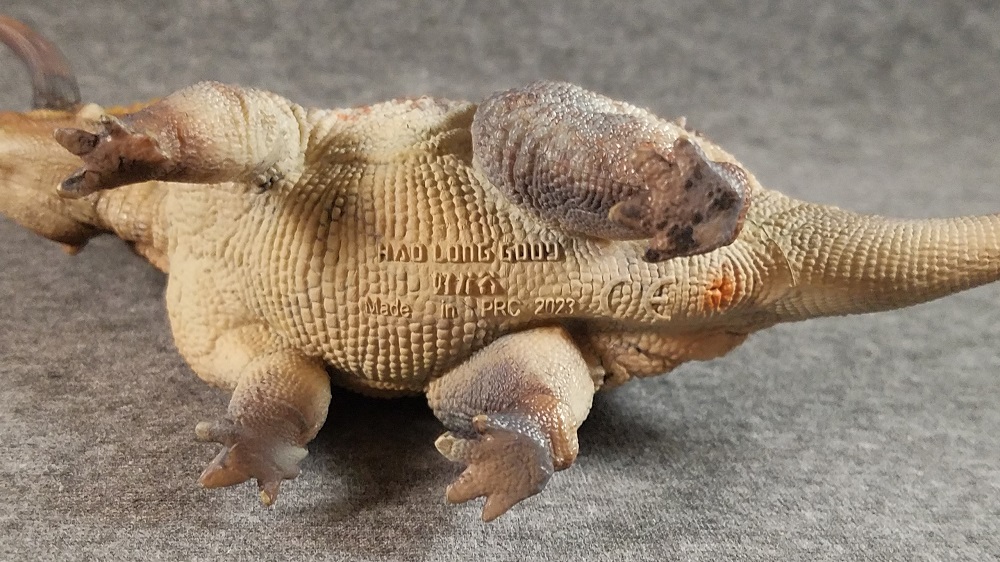
Support the Dinosaur Toy Blog by making dino-purchases through these links to Ebay and Amazon. Disclaimer: links to Ebay.com and Amazon.com on the The Dinosaur Toy Blog are often affiliate links, when you make purchases through these links we may make a commission

Having gradually, and then all-at-once, been sold on Haolonggood “lock-stock-and-barrel”, I ordered the darker beauty of this pair during an 11/11/23 massive discount sale and am awaiting its arrival.
I always found the horns of this genus to bear a weird resemblance to some model cattle horns, but – hey – it was what it was before there were cattle. So now I’m a fan.
I too have no inclination to get this toy due to already owning the CollectA and Safari versions, but it certainly is nice. I’d love for Haolonggood to tackle ceratopsids that haven’t already received toys like Agujaceratops, Anchiceratops, and Judiceratops.
Centrosaurus and Torosaurus would also be great.
Nice! I’d snatch this up in a second if I didn’t already have the Safari version!